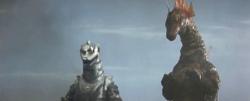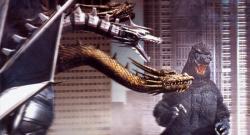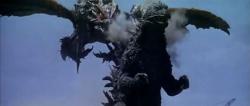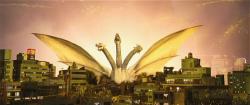Reviews
Godzilla x Mothra x Mechagodzilla: Tokyo SOS / SOS Gojira tai Mosura tai Mekagojira Tokyo Esu O Esu
Masaaki Tezuka
Japan, 2003
Credits
Review by Matthew Derby
Posted on 27 February 2013
Source Amazon Instant Video
Categories The Compleat Godzilla
Godzilla: Tokyo S.O.S. is the last film in the recent series of successful Godzilla reboots with spectacularly awful names directed by Masaaki Tezuka, who’d earned his stripes reviving the Mothra franchise in the 1990s. It’s not surprising, then, that the sequel to the previous year’s Godzilla Against Mechagodzilla features an appearance by the world’s most dangerous lepidopteran and the twin fairies who act as its translators to the human world. S.O.S. also shares Mechagodzilla’s preoccupation with genetic engineering, and makes an even more overt connection between the fictional resurrection of the original monster’s bones and the real-world effort on the part of Toho to inject a few stem cells into a brand that is perpetually on the brink of extinction.
S.O.S. picks up where Mechagodzilla left off—Godzilla, having survived the Absolute Zero Cannon, has disappeared into the Pacific, and the Japan Counter-Xenomorph Self Defense Force (JXSDF) begins restoring Kiryu in preparation for the monster’s imminent return. But as it turns out, Godzilla is not the only monster who’s put off by the use of the original Godzilla’s bones in the construction of Kiryu: Mothra pays a visit to the home of Dr. Chujo, the ethnographer who discovered the giant moth back in 1961, to express its concern. Aided by the Shobijin twins, it explains that if Japan returns Godzilla’s bones to their rightful place at the bottom of the Pacific, Mothra will defend Japan against Godzilla. But if Japan refuses, Mothra will declare war on all humanity. If this sounds like a rather raw deal, imagine Chujo’s concern when no one in the Japanese government will listen to the feverish ramblings of an old linguist.
Soon enough, Godzilla returns, presumably to take care of the unfinished business of pulverizing Tokyo. Before he can get any serious work done, however, Dr. Chujo’s resourceful grandson calls Mothra by arranging the desks at his elementary school into a special pattern that causes the moth to appear instantly (a strategy Chujo deployed in the original Mothra film). Mothra descends from the sky and envelops Godzilla in a punishing cloud of dust. The two creatures battle while the JXSDF struggles to bring Kiryu back online, a feat that requires two high-tech aircraft and a microwave power supply. Although Mothra puts up a considerable fight, it eventually begins to lose its golden scales, an event that, Dr. Chujo points out, means that it is dying. Its larvae sense their mother’s demise all the way from Infant Island, provoking them to hatch and squirm to the rescue. Meanwhile, Kiryu and Godzilla grapple in the streets of Tokyo, tossing one another into buildings that crumble like sand under their weight. The larvae arrive just in time to watch Godzilla incinerate their mother in front of their eyes, and they retaliate by encasing the great monster in a silken cocoon. In a moment of unexpected beauty, Godzilla stands dumbfounded before its cybernetic doppelgänger in the ruined streets while bits of silken thread drift in the night air. There is an uncharacteristically long pause as the colossal beast considers its past and its future in the same moment. And then Godzilla falls, fully encased in the silken cocoon, in a clear nod to the ending sequence of Mothra vs. Godzilla. Kiryu then achieves a sort of sentience—its pilots can no longer control its movement, and it carries Godzilla out into the Pacific where the two monsters descend to the depths, presumably for eternity.
What’s most notable throughout this film is the considerable guilt the humans express at having taken part in Kiryu’s creation. The climax features a tearful, self-flagellating apology to the mechanical Godzilla clone by its pilot (also Dr. Chujo’s nephew, Yoshito) that echoes the Kiryu-mourning done by Sara in the previous film. It is strange to see so many people reacting so strongly to what is essentially a massive, insensate weapon of destruction. It’s not the first time in the franchise’s history that Godzilla’s DNA has been used against him, but it’s most certainly the most morally conflicted. This anxiety is so strongly felt that it seems imposed by the filmmakers themselves, as if their uncertainty about continuing the franchise by literally reviving Godzilla’s corpse has bled into the script. The film ends with a close-up shot of a vial of Godzilla’s genetic material, secured in a lab at some undisclosed location. On the surface, the image functions as a teaser for future installments of monster mayhem, but with all of the hand-wringing ambivalence that attends Godzilla: Tokyo S.O.S., the shot feels more like a provocation—who dares to take up the burden of this franchise next?
More The Compleat Godzilla
-

Godzilla
1954 -

Godzilla Raids Again
1955 -

King Kong vs. Godzilla
1962 -

Mothra vs. Godzilla
1964 -

Ghidorah, the Three-Headed Monster
1964 -

Invasion of Astro-Monster
1965 -

Ebirah, Horror of the Deep
1966 -

Son of Godzilla
1967 -

Destroy All Monsters!
1968 -

All Monsters Attack
1969 -

Godzilla Vs. Hedorah
1971 -

Godzilla vs. Gigan
1972 -

Godzilla vs. Megalon
1973 -

Godzilla vs. Mechagodzilla
1974 -

Terror of Mechagodzilla
1975 -

The Return of Godzilla
1984 -

Godzilla vs. Biollante
1989 -

Godzilla vs. King Ghidorah
1991 -

Godzilla vs. Mothra
1992 -

Godzilla vs. Mechagodzilla
1993 -

Godzilla vs. SpaceGodzilla
1994 -

Godzilla vs. Destoroyah
1995 -

Godzilla 2000
1999 -

Godzilla vs. Megaguirus
2000 -

Godzilla, Mothra and King Ghidorah: Giant Monsters All-Out Attack
2001 -

Godzilla Against Mechagodzilla
2002 -

Godzilla: Tokyo S.O.S.
2003 -

Godzilla: Final Wars
2004
We don’t do comments anymore, but you may contact us here or find us on Twitter or Facebook.



